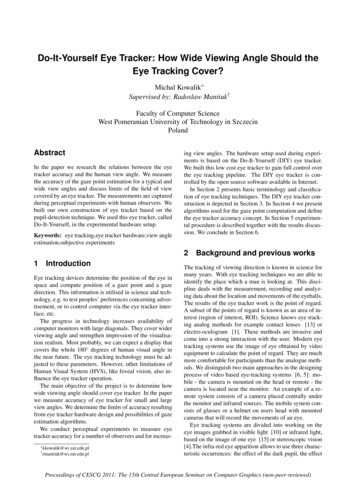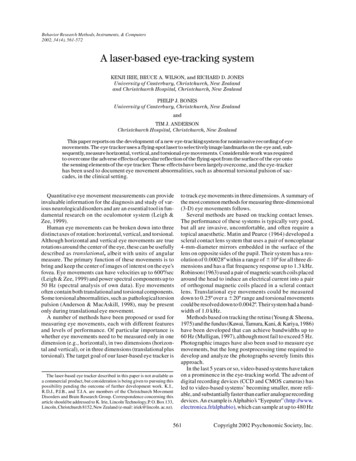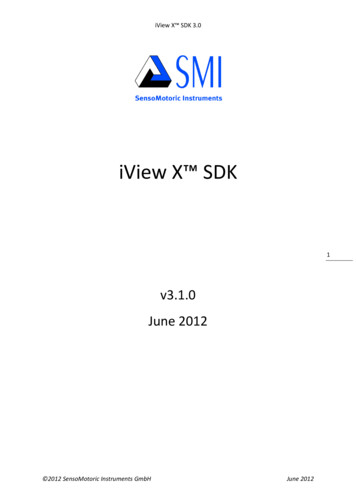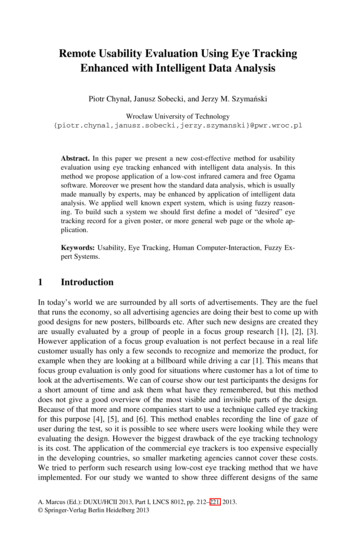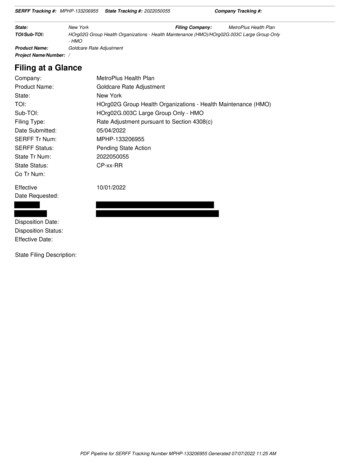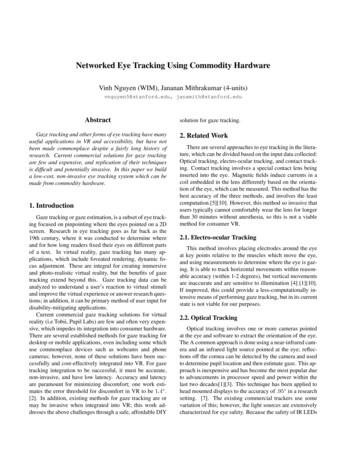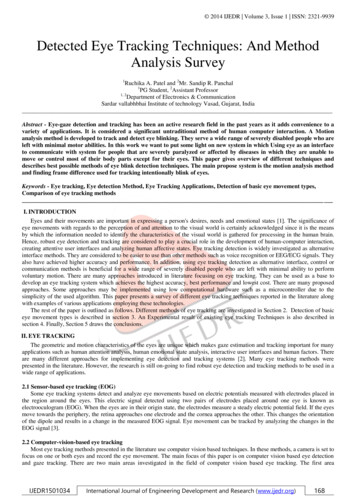
Transcription
2014 IJEDR Volume 3, Issue 1 ISSN: 2321-9939Detected Eye Tracking Techniques: And MethodAnalysis Survey1Ruchika A. Patel and 2Mr. Sandip R. Panchal1PG Student, 2Assistant Professor1, 2Department of Electronics & CommunicationSardar vallabhbhai Institute of technology Vasad, Gujarat, IndiaAbstract - Eye-gaze detection and tracking has been an active research field in the past years as it adds convenience to avariety of applications. It is considered a significant untraditional method of human computer interaction. A Motionanalysis method is developed to track and detect eye blinking. They serve a wide range of severely disabled people who areleft with minimal motor abilities. In this work we want to put some light on new system in which Using eye as an interfaceto communicate with system for people that are severely paralyzed or affected by diseases in which they are unable tomove or control most of their body parts except for their eyes. This paper gives overview of different techniques anddescribes best possible methods of eye blink detection techniques. The main propose system is the motion analysis methodand finding frame difference used for tracking intentionally blink of eyes.Keywords - Eye tracking, Eye detection Method, Eye Tracking Applications, Detection of basic eye movement types,Comparison of eye tracking methodsI. INTRODUCTIONEyes and their movements are important in expressing a person's desires, needs and emotional states [1]. The significance ofeye movements with regards to the perception of and attention to the visual world is certainly acknowledged since it is the meansby which the information needed to identify the characteristics of the visual world is gathered for processing in the human brain.Hence, robust eye detection and tracking are considered to play a crucial role in the development of human-computer interaction,creating attentive user interfaces and analyzing human affective states. Eye tracking detection is widely investigated as alternativeinterface methods. They are considered to be easier to use than other methods such as voice recognition or EEG/ECG signals. Theyalso have achieved higher accuracy and performance. In addition, using eye tracking detection as alternative interface, control orcommunication methods is beneficial for a wide range of severely disabled people who are left with minimal ability to performvoluntary motion. There are many approaches introduced in literature focusing on eye tracking. They can be used as a base todevelop an eye tracking system which achieves the highest accuracy, best performance and lowest cost. There are many proposedapproaches. Some approaches may be implemented using low computational hardware such as a microcontroller due to thesimplicity of the used algorithm. This paper presents a survey of different eye tracking techniques reported in the literature alongwith examples of various applications employing these technologies.The rest of the paper is outlined as follows. Different methods of eye tracking are investigated in Section 2. Detection of basiceye movement types is described in section 3. An Experimental result of existing eye tracking Techniques is also described insection 4. Finally, Section 5 draws the conclusions.II. EYE TRACKINGThe geometric and motion characteristics of the eyes are unique which makes gaze estimation and tracking important for manyapplications such as human attention analysis, human emotional state analysis, interactive user interfaces and human factors. Thereare many different approaches for implementing eye detection and tracking systems [2]. Many eye tracking methods werepresented in the literature. However, the research is still on-going to find robust eye detection and tracking methods to be used in awide range of applications.2.1 Sensor-based eye tracking (EOG)Some eye tracking systems detect and analyze eye movements based on electric potentials measured with electrodes placed inthe region around the eyes. This electric signal detected using two pairs of electrodes placed around one eye is known aselectrooculogram (EOG). When the eyes are in their origin state, the electrodes measure a steady electric potential field. If the eyesmove towards the periphery, the retina approaches one electrode and the cornea approaches the other. This changes the orientationof the dipole and results in a change in the measured EOG signal. Eye movement can be tracked by analyzing the changes in theEOG signal [3].2.2 Computer-vision-based eye trackingMost eye tracking methods presented in the literature use computer vision based techniques. In these methods, a camera is set tofocus on one or both eyes and record the eye movement. The main focus of this paper is on computer vision based eye detectionand gaze tracking. There are two main areas investigated in the field of computer vision based eye tracking. The first areaIJEDR1501034International Journal of Engineering Development and Research (www.ijedr.org)168
2014 IJEDR Volume 3, Issue 1 ISSN: 2321-9939considered is eye detection in the image, also known as eye localization. The second area is eye tracking, which is the process ofeye gaze direction estimation. Based on the data obtained from processing and analyzing the detected eye region, the direction ofeye gaze can be estimated then it is either used directly in the application or tracked over subsequent video frames in the case ofreal-time eye tracking systems. Eye detection and tracking is still a challenging task, as there are many issues associated with suchsystems. These issues include degree of eye openness, variability in eye size, head pose, etc. Different applications that use eyetracking are affected by these issues at different levels. Several computer-vision-based eye tracking approaches have beenintroduced.Pattern recognition for eye trackingDifferent pattern recognition techniques, such as template matching and classification, have proved effective in the field of eyetracking. Raudonis et al. [4] used principal component analysis (PCA) to find the first six principal components of the eye image toreduce dimensionality problems, which arise when using all image pixels to compare images. Then, Artificial Neural Network(ANN) is used to classify the pupil position. The training data for ANN is gathered during calibration where the user is required toobserve five points indicating five different pupil positions. The use of classification slows the system and hence it requires someenhancements to be applicable. In addition, the system is not considered a real time eye tracking system. The proposed algorithmwas not tested on a known database which means the quality of the system might be affected by changes in lighting conditions,shadows, distance of the camera, the exact position in which the camera is mounted, etc. The algorithm requires processing whichcannot be performed by low computational hardware such as a microcontroller.Tang and Zhang [5] suggested a method that uses the detection algorithm combined with gray prediction to serve eye trackingpurposes. The GM(1,1) model is used in the prediction of the location of an eye in the next video frame. The predicted location isused as the reference for the region of eye to be searched. The method uses low-level data in the image in order to be fast but thereare no experimental results evaluating the performance of the method.Kuo et al. [6] proposed an eye tracking system that uses the Particle filter which estimates a sequence of hidden parametersdepending on the data observed. After detecting possible eyes positions, the process of eye tracking starts. For effective and reliableeye tracking, the gray level histogram is selected as the characteristics of the particle filter. Using low-level features in the imagemakes it a fast algorithm. High accuracy is obtained from the system; however, the real time performance was not evaluated, thealgorithm was tested on images not videos and the images were not taken from a known database and, thus, the accuracy andperformance of the algorithm may decrease when utilized in a real-world application.Lui et al. [7] suggested a fast and robust eye detection and tracking method which can be used with rotated facial images. Thecamera used by the system is not head mounted. A Viola-Jones face detector, which is based on Haar features, is used to locate theface in the whole image. Then, Template Matching (TM) is applied to detect eyes. Zernike Moments (ZM) is used to extractrotation invariant eye characteristics. Support Vector Machine (SVM) is used to classify the images to eye/non-eye patterns. Theexact positions of the left and right eyes are determined by selecting the two positions having the highest values among the foundlocal maximums in the eye probability map. Detecting the eye region is helpful as a pre-processing stage before iris/pupil tracking.Especially, it allows for eye detection in rotated facial images. This work presented a simple eye tracking algorithm but the resultsof the method evaluation were not reported and thus the proposed eye tracking method is weak and not usable.Hotrakool et al. [8] introduced an eye tracking method based on gradient orientation pattern matching along with automatictemplate updates. The method detects the iris based on low level features and motion detection between subsequent video frames.The method can be used in applications that require real-time eye tracking with high robustness against change in lightingconditions during operation. The computational time is reduced by applying down-sampling on the video frames. The methodachieves high accuracy. However, the experiments were performed on videos of a single eye, which eliminates all surroundingnoise, and a known database was not used. The method detects the iris but does not classify its position. The method requiresminimal CPU processing time among other real-time eye tracking methods investigated in this survey. The motion detectionapproach discussed in this paper is worth being considered in new algorithms to obtain the minimal required CPU processing timein eye tracking applications.Yuan and Kebin [9] presented Local and Scale Integrated Feature (LoSIF) as a new descriptor for extracting the features of eyemovement based on a non-intrusive system, which gives some tolerance to head movements. The feature descriptor uses two-levelHaar wavelet transform, multi-resolution characteristics and effective dimension reduction algorithm, to find the local and scale eyemovement features. Support Vector Regression is used in mapping between the appearance of the eyes and the gaze direction,which correspond to each eye's appearance. The focus of this method is to locate the eye without classifying its position or gazedirection. The method was found to achieve high accuracy in iris detection, which makes this method useful in iris detection andsegmentation which is important for eye tracking. However, the real-time performance was not evaluated.Fu and Yang [10] proposed a high-performance eye tracking algorithm in which two eye templates, one for each eye, aremanually extracted from the first video frame for system calibration. The face region in a captured frame is detected and anormalized 2-D cross-correlation is performed for matching the template with the image. Eye gaze direction is estimated by irisdetection using edge detection and Hough circle detection. They used their algorithm to implement a display control application.However, it has an inflexible calibration process. The algorithm was not tested on a variety of test subjects and the results were notclearly reported which requires the algorithm to be investigated carefully before choosing to implement it.Mehrubeoglu et al. [11] introduced an eye detection and tracking system that detects the eyes using template matching. Thesystem uses a special customized smart camera which is programmed to continuously track the user's eye movements until the userstops it. Once the eye is detected, the region of interest (ROI) containing only the eye is extracted with the aim of reducing theprocessed region. From their work, it can be concluded that it is a fast eye tracking algorithm with acceptable performance. Thealgorithm could be a nice feature to be added to modern cameras. A drawback is that the experiments were not performed using aIJEDR1501034International Journal of Engineering Development and Research (www.ijedr.org)169
2014 IJEDR Volume 3, Issue 1 ISSN: 2321-9939database containing different test subjects and conditions, which reduces the reliability of the results. In addition, the algorithmlocates the coordinates but does not classify the eye gaze direction to be left, right, up or down.Eye tracking based on corneal reflection pointsMany computer vision based eye trackers use light reflection points on the cornea to estimate the gaze direction. Figure 1 showsthe corneal reflection points in an eye image [12]. Another name for eye images containing corneal reflection points is PurkinjeImage. When using this approach, the vector between the center of the pupil and the corneal reflections is used to compute the gazedirection. A simple calibration procedure of the individual is usually needed before using the eye tracker [2 12].Figure1. Corneal reflection points [12].Yang et al. [13] proposed a scheme which employs gray difference between the face, pupils and corneal reflection points foreye detection. The proposed scheme was tested under a cross-ratio-invariant-based eye tracking system. The test included userswearing glasses and other accessories and the results showed the ability of the system to eliminate the optical reflective effect ofaccessories and glasses. The scheme first prepares for gaze tracking by a preprocessing stage applied on cropped faces. This isparticularly useful in applications which use a very close camera. The results are not detailed and not performed on a databasecontaining various test subjects under different conditions which makes the algorithm weak when considered for use in real-worldapplications. In addition, the required CPU time was not addressed and thus the algorithm needs optimization to determine whetherit works in real-time applications.Yang et al. [14] presented an algorithm based on the difference in the gray level of the pupil region and the iris region. Theimage of the eye region is binarized and an estimate position of the pupil is detected. The exact position of the pupil is found by thevertical integral projection and the horizontal integral projection. The projection area contains the corneal glints and the pupil. Thegray level of the pixels representing reflection points is the highest among all pixels. To apply their presented gaze tracking method,the points of corneal reflection must have known coordinates. The system uses hardware which adds limitations and inflexibility forpupil detection. The algorithm was tested on images containing a part of the face. It needs to be applied on different test subjects toprove the accuracy and performance of the algorithm. The required CPU time was not reported which does not make the algorithmfeasible for adoption in real-time applications. However, the experiments showed that the algorithm achieves reasonably highaccuracy.Eye tracking based on shapeAnother approach for eye detection and tracking is to find the location of the iris or the pupil based on their circular shape orusing edge detection. Chen and Kubo [15] proposed a technique where a sequence of face detection and Gabor filters is used. Thepotential face regions in the image are detected based on skin color. Then, the eye candidate region is determined automaticallyusing the geometric structure of the face. Four Gabor filters with different directions (0, π/4, π/2, 3π/4) are applied to the eyecandidate region. The pupil of the eye does not have directions and thus, it can be easily detected by combining the four responsesof the four Gabor filters with a logical product. The system uses a camera which is not head mounted. The accuracy of thealgorithm is not investigated and the required CPU time is not mentioned which does not make the algorithm preferable for realworld applications compared to other algorithms.Kocejko et al. [16] proposed the Longest Line Detection (LLD) algorithm to detect the pupil position. This algorithm is basedon the assumption that the pupil is arbitrary circular. The longest vertical and horizontal lines of the pupil are found. The center ofthe longest line among the vertical and horizontal lines is the pupil center. The proposed eye tracking system requires inflexiblehardware which requires relatively difficult installation. The accuracy is not discussed and the performance of the system might beaffected by changes in illumination, shadows, noise and other effects because the experiments were performed under specialconditions and did not use a variety of test samples in different conditions.Khairosfaizal and Nor'aini [17] presented a straightforward eye tracking system based on mathematical Circular Houghtransform for eye detection applied to facial images. The first step is detecting the face region which is performed by an existingface detection method. Then the search for the eye is based on the circular shape of the eye in a two dimensional image. Their workadded value to academic research but not to real-world applications.Pranith and Srikanth [18] presented a method which detects the inner pupil boundary by using Circular Hough transformationwhereas the outer iris boundary is detected by circular summation of intensity from the detected pupil center and radius. Thisalgorithm can be used in an iris recognition system for iris localization because it is applied to cropped eye images. However, itneeds further analysis to obtain its accuracy and real-time performance by applying it on a database containing variant images.Sundaram et al. [19] proposed an iris localization method that identifies the outer and inner boundaries of the iris. Theprocedure includes two basic steps: detection of edge points and Circular Hough transform. Before these steps are applied,bounding boxes for iris region and pupil area are defined to reduce the complexity of the Hough transform as it uses a votingIJEDR1501034International Journal of Engineering Development and Research (www.ijedr.org)170
2014 IJEDR Volume 3, Issue 1 ISSN: 2321-9939scheme that considers all edge points (Xi,Yi) over the image for all possible combinations of center coordinates (x0, y0) anddifferent possible values of the radius r. The algorithm is applicable in applications where a camera close to the eye is used such asin iris recognition systems. The algorithm was tested on the UBIRIS database, which contains images with different characteristicslike illumination change. The algorithm is relatively fast when compared to non real-time applications but it is not suitable for realtime eye tracking due to its complexity.Alioua et al. [20] presented an algorithm that handles an important part of eye tracking, which is analyzing eye state(open/closed) using iris detection. Gradient image is used to mark the edge of the eye. Horizontal projection is then computed forthe purpose of detecting upper and lower boundaries of the eye region and the Circular Hough transform is used for iris detection.This algorithm can be useful in eye blinking detection, especially since the possible output classes are limited: open, closed or notan eye. When used in a control application, it can increase the number of possible commands. Due to its importance, the algorithmis required to be fast but no required CPU time was mentioned, although indicating the required CPU time could be useful.Eye tracking using dark and bright pupil effectThere are two illumination methods used in the literature for pupil detection: the dark pupil and the bright pupil method. In thedark pupil method, the location of a black pupil is determined in the eye image captured by the camera. This causes some issueswhen the user has dark brown eyes because of the low contrast between the brown iris and the black pupil. The bright pupil methoduses the reflection of infrared light from the retina which makes the pupil appear white in the eye image. Figure 2 shows the darkand bright pupil effect.Yoo et al. [21] proposed using cross-ratio-invariance for a gaze tracking algorithm. The proposed algorithm has been found toachieve very low accuracy. To enhance it, a virtual plane tangent to the cornea is added. The enhancement did not solve all issuesas the system remains complex due to using two cameras to obtain the difference between dark and bright pupil images for pupilposition detection [22].(a)(b)Figure 2 (a) Dark and (b) Bright pupil effects [2].Eye tracking using eye modelsEye models can be used for eye tracking. Zhu and Ji [23] proposed two new schemes to allow natural head movement for eyetracking and minimize the calibration of the eye tracking system to only once for each new user. The first scheme estimates the 3D eye gaze directly. The cornea of the eye is modeled as a convex mirror. Based on the characteristics of a convex mirror, theeye's 3-D optic axis is estimated. The visual axis represents the actual 3-D eye gaze direction of the user. It is determined afterknowing the angle deviation between the visual axis and optic axis in calibration. The second scheme does not require estimatingthe 3-D eye gaze, and the gaze point can be determined implicitly using a gaze mapping function. The gaze mapping function isupdated automatically upon head movement using a dynamic computational head compensation model. The proposed schemesrequire medical and physical background as well as image processing techniques. The schemes are complex and hence they arenot applicable for real-time eye tracking. It would be beneficial if the used algorithms, equations and phases were optimized. Inaddition, the system uses inflexible hardware which is not preferred in real applications. The schemes were not tested on adatabase containing various test subjects and conditions.Hybrid eye tracking techniquesA mix of different techniques can be used for eye tracking. Huang et al. [24] suggested an algorithm to detect eye pupil basedon intensity, shape, and size. Special Infrared (IR) illumination is used and thus, eye pupils appear brighter than the rest of the face.The intensity of the eye pupil is used as the primary feature in pupil detection. However, some other bright objects might exist inthe image. To separate the pupil from bright objects existing in the image, other pupil properties can be used, such as pupil size andshape. Support Vector Machine is used to locate the eye location from the detected candidates. The used hardware, including the IRLEDs and the IR camera, is not expensive. The algorithm has been used in a driver fatigue detection application. The algorithm canbe considered a new beginning for real-time eye tracking systems if it is tested further with different test subjects and differentclassification functions in order to reach the most optimized eye algorithm. The required CPU time was not mentioned although itis important in driver fatigue detection applications as they are real-time applications.Using a corneal reflection and energy controlled iterative curve fitting method for efficient pupil detection was proposed by LiandWee [12]. Ellipse fitting is needed to acquire the boundary of the pupil based on a learning algorithm developed to performiterative ellipse fitting controlled by a gradient energy function. This method uses special hardware which has been implementedspecifically for this algorithm. It has been used in a Field-of-View estimation application and can be used in other applications.Coetzer and Hancke [25] proposed a system for eye tracking which uses an IR camera and IR LEDs. It captures the bright anddark pupil images subsequently such that they are effectively the same image but each has been taken in different illuminationIJEDR1501034International Journal of Engineering Development and Research (www.ijedr.org)171
2014 IJEDR Volume 3, Issue 1 ISSN: 2321-9939conditions. Two groups of infrared LEDs are synchronized with the IR camera. The first is placed close to the camera's lens toobtain the bright pupil effect and the second about 19.5 cm away from the lens, to produce the dark pupil effect. The images arethen subtracted from each other and a binary image is produced by thresholding the difference. This technique has been presentedby Hutchinson [26]. The binary image contains white blobs that are mapped to the original dark pupil image. The sub-images thatresult from the mapping are potential eye candidates. The possible eye candidate sub-images are classified into either eyes or noneyes. Artificial neural networks (ANN), support vector machines (SVM) and adaptive boosting (AdaBoost) have been consideredas classification techniques in this work. The system is ready for further improvements and enhancements. It was utilized in adriver fatigue monitoring system. It does not require calibration for each user because it uses a dataset for training and featureextraction. The best features to be used and flexible hardware implementation can be investigated further in order to make thealgorithm a part of a bigger eye tracking system or eye location classification system. The images used in experiments were eyeimages after the background and noise were eliminated. This reduces the expectations of this algorithm performance in realapplications.III. DETECTION OF BASIC EYE MOVEMENT TYPESDifferent types of eye movements can be detected from the processed EOG signals. In this work, saccades, fixations, and blinksform the basis of all eye movement features used for classification. The robustness of the algorithms for detecting these is key toachieving good recognition performance. Saccade detection is particularly important because fixation detection, eye movementencoding, and the wordbook analysis are all reliant on it. In the following, we introduce our saccade and blink detection algorithmsand characterize their performance on EOG signals recorded under constrained conditions.3.1 Saccade and Fixation DetectionFor saccade detection, we developed the so-called Continuous Wavelet Transform—Saccade Detection (CWT-SD) algorithm (seeFig. 4 for an example). Inputs to CWT-SD are the denoised and baseline drift removed EOG signal components EOGh andEOGv. CWT-SD first computes the continuous 1D wavelet coefficients at scale 20 using a Haar mother wavelet. Let s be one ofthese signal components and the mother wavelet. The wavelet coefficientof s at scale a and position b is defined(S) By applying an application-specific threshold( ) on the coefficients{(( ))( ) CWT-SD creates a vector M with elements( )( )( )This step divides EOGh and EOGv in saccadic (M 1,-1) and nonsaccadic (fixational) (M 0) segments. Saccadic segmentsshorter than 20 ms and longer than 200 ms are removed. These boundaries approximate the typical physiological saccadecharacteristics described in literature [30]. CWT-SD then calculates the amplitude and direction of each detected saccade. Thesaccade amplitude SA is the difference in EOG signal amplitude before and after the saccade (c.d. Fig. 4). The direction is derivedfrom the sign of the corresponding elements in M. Finally, each saccade is encoded into a character representing the combinationof amplitude and direction. For example, a small saccade in EOGh with negative direction gets encoded as ―r‖ and a large saccadewith positive direction as ―L.‖Figure 4.Continuous wavelet transform—saccade detection algorithm. (a) Denoised and baseline drift removed horizontal EOGsignal during reading with example saccade amplitude (Sa); (b) The transformed wavelet signal (EOGWL), with applicationspecific small () and large () thresholds; (c) Marker vectors for distinguishing between small () and large() saccades; and (d) Example character encoding for part of the EOG signal.IJEDR1501034International Journal of Engineering Development and Research (www.ijedr.org)172
2014 IJEDR Volume 3, Issue 1 ISSN: 2321-9939Humans typically alternate between saccades and fixations. This allows us to also use CWT-SD for detecting fixations. Thealgorithm exploits the fact that gaze remains stable during a fixation. This results in the corresponding gaze points, i.e., The pointsin a visual scene that the gaze is directed at, to cluster together closely in time. Therefore, fixations can be identified byThresholding on the dispersion of these gaze points [31]. For a segment S of length n comprised of a horizontal and a verticalEOG signal component, the dispersion is calculated asDispersion(S) max( ) – min( ) max( ) – min(( )Initially, all nonsaccadic segments are assumed to contain a fixation. The algorithm then drops segments for which thedispersion is above a maximum thresholdof 10,000 or if its duration is below a minimum thresholdof 200 ms. Thevalue ofwas derived as part of the CWTSD evaluation; that ofapproximates the typical average fixation durationreported earlier.A particular activity may require saccadic eye movements of different distance and direction. For example, reading involves afast sequence of small saccades while scanning each line of text, while large saccades are required to jump back to the beginning ofthe next line. We opted to detect saccades with two different amplitudes, ―small‖ and ―large.‖This requires two thresholds,small andlarge, to divide the range of possible values of C into three bands (see Fig. 4): no saccade (small C small ), small saccade (large C small orsmall C large ), and large saccade (C large orC large ). Depending on its peak value, each saccade is then assigned to one of these bands. To evaluate the
Eye detection and tracking is still a challenging task, as there are many issues associated with such systems. These issues include degree of eye openness, variability in eye size, head pose, etc. Different applications that use eye tracking are affected by these issues at different levels. Several computer-vision-based eye tracking approaches .
